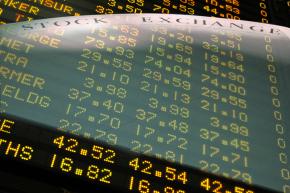Is the economic crisis over?
points out that while the Federal Reserve has taken unprecedented action to bail out the banks, ordinary people are still feeling the effects of the crisis.
NEXT TIME you hear Wall Street experts claim that the economy isn't doing too badly after all, check your wallet. You'll find a good deal less cash there, courtesy of fast-rising food and gas prices, while wages remain stagnant or shrink.
Even at the peak of the 2000s boom, median family income failed to recover the losses from the last recession, the first time this has happened in an economic expansion since the Second World War. Now a further decline in living standards is underway.
"The bottom line: The U.S. may have to get used to a new definition of normal, characterized by weaker productivity gains, slower economic growth, higher unemployment and a diminished financial-services industry," Bloomberg News noted.
If Wall Street has nevertheless been heaving a sigh of relief, it's because the Federal Reserve Bank made it clear it would do everything in its power to keep banks from collapsing under the weight of bad debt tied to mortgages--as evidenced by the bailout of Wall Street that the Fed engineered when the investment bank Bear Stearns went to the edge of bankruptcy in March.
Since last fall, the Fed has stepped in repeatedly to cut interest rates--from 5 percent in September to 2 percent today--and create new "lending facilities" to shovel cash into the accounts of commercial banks. And--for the first time since the 1930s Great Depression--the Fed is making loans directly to Wall Street investment banks, which are mostly outside its regulatory authority.
The Fed's most dramatic action, though, was its decision to force a sale of Bear Stearns to JPMorgan Chase, guaranteed by $29 billion in taxpayer money. The Fed justified this unprecedented--and legally questionable--action on the basis that a bankruptcy at Bear Sterns could have caused a meltdown of the entire financial system.
This might have been an exaggeration--but maybe not. Bear Stearns was a key player in the market for credit-default swaps, a form of insurance paid if the value of bonds or other securities falls below a certain threshold. The total value of all these credit-default swaps outstanding is an estimated $62 trillion, far greater than the underlying assets they are meant to insure and more than five times the size of the entire U.S. economy.
Since credit-default swaps are bought and sold privately, no one knows which banks are at risk. Fed Chair Ben Bernanke's fear was that a failure by one investment bank could knock down the rest like a row of dominoes.
"The decision by the Fed to offer emergency liquidity to Bear Stearns and to facilitate its acquisition by JPMorgan Chase had less to do with the size of Bear's balance sheet than with its central role in markets for credit-default and interest-rate swaps," wrote Andrew Palmer, the banking correspondent for The Economist magazine.
By forcing Bear Stearns to sell out to JP Morgan for a fraction of its book value, the Fed halted what was becoming a run on the shadow banking system that has emerged over the last 30 years as a result of deregulation of finance in the U.S. and internationally. The Fed also agreed to accept mortgage-backed securities as collateral, even though those securities are now worth far less than their supposed value and are virtually unsellable on the open market.
THE FED'S lifeline has saved the big banks from an immediate solvency crisis. But the banks have already recorded $150 billion in losses related to sub-prime mortgages, and according to the credit rating agency Standard & Poor's, the total losses could hit $285 billion.
As a result, the banks have been forced to raise capital by seeking outside investment. A third of the new capital raised by banks has come from sovereign wealth funds controlled by governments in the Middle East and Asia, an indicator of the weakness of the U.S. economy. Moreover, Citigroup, the biggest bank in the U.S., has announced plans to sell off a whopping $400 billion in assets in order to recover.
Meanwhile, the banks are imposing much tougher terms for new loans, thereby dragging down the economy. Although estimated U.S. gross domestic product (GDP) growth for the first quarter of 2008 was revised upward--from 0.6 percent to 1 percent--the prospects remain lousy at best.
"The financial engine is a major source of increased productivity and growth," Wall Street economist Allen Sinai told a reporter. "As it consolidates, we'll be looking at a stagnant U.S. economy for a while."
Or maybe something worse. The housing crisis is still in an early stage and will continue to bleed the economy for the foreseeable future. According to the National Association of Realtors, the median price for a single-family home fell 7.7 percent in the first quarter of the year, the biggest decline in nearly 30 years.
What's more, Moody's Economy.com estimates that 8.5 million homeowners are "underwater" on mortgages--that is, they owe more than their homes are worth. That number could go as high as 12 million by 2009.
In these circumstances, millions of people--especially those who have lost their jobs--will have little choice but to walk away from their homes. The company RealtyTrac reported that foreclosures jumped 65 percent in April over the same period a year earlier. Across the U.S., nearly a quarter of a million homeowners were facing foreclosure last month--accounting for 2 percent of all homes.
The farther house prices fall, the bigger the hit to consumer spending, noted economist Dean Baker of the Center for Economic and Policy Research. "If we're losing more than $4 trillion in housing wealth in the course of a year, that's over $60,000 per homeowner," he told the Los Angeles Times. "That has an enormous impact on consumption."
If the U.S. economy is still eking out positive growth, it's in part because the weaker dollar has allowed U.S. exports to become more competitive. But exporting to China, for example, isn't a panacea, since the bulk of the Chinese economy is geared to exports, principally to the U.S.
According to Sun Mingchun of Lehman Brothers, China will soon be hit hard by a slowdown in exports. "With so much latent overcapacity, an export-led slowdown could trigger a chain reaction which, in the worst case, could threaten the stability of [China's] financial and economic system," he told Britain's Daily Telegraph.
The Telegraph's Ambrose Evans-Pritchard spelled out the grim conclusion: "Britain, Europe, Japan and China will go down before America comes back up. This is turning into a synchronized bust, after all. The Global Slump of 2008-09 is under way."



